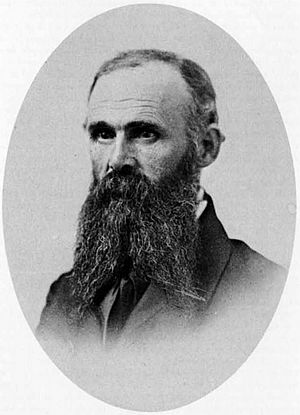John W. Phelps facts for kids
Quick facts for kids
John W. Phelps
|
|
|---|---|

John Wolcott Phelps
|
|
| Birth name | John Wolcott Phelps |
| Born | November 13, 1813 Guilford, Vermont |
| Died | February 2, 1885 (aged 71) Guilford, Vermont |
| Place of burial |
Christ Church Cemetery, Guilford, Vermont
|
| Allegiance | United States of America Union |
| Service/ |
United States Army Union Army |
| Years of service | 1836–1859; 1861–1862 |
| Rank | |
| Unit | 4th U.S. Artillery |
| Commands held | 1st Vermont Infantry |
| Battles/wars | Seminole Wars Mexican–American War Utah War American Civil War |
John Wolcott Phelps (born November 13, 1813 – died February 2, 1885) was an important figure in American history. He served as a general in the Union Army during the American Civil War. He was also a writer, a strong supporter of ending slavery (an abolitionist), and even ran for president.
Contents
Early Life and Military Career
John Wolcott Phelps was born in Guilford, Vermont. His father was Judge John Phelps. John attended the United States Military Academy starting in 1832. He graduated in 1836 and became a Second Lieutenant in the 4th U.S. Artillery.
He fought in several conflicts early in his career. These included the Creek and Seminole Wars in 1838. He also took part in the Trail of Tears that same year. He was promoted to First Lieutenant in 1838 and Captain in 1850.
During these years, he served in Florida and the Mexican–American War. From 1857 to 1859, he was part of the Mormon Expedition. He later left the army in 1859. Before the Civil War, he lived in Brattleboro, Vermont. There, he wrote articles warning about the growing power of states that allowed slavery.
Service in the Civil War
When the Civil War began, John Phelps quickly rejoined the military. On May 2, 1861, he became a Colonel of the 1st Vermont Infantry. His regiment arrived at Fortress Monroe, Virginia, soon after.
He was promoted to brigadier general on May 27, 1861. In November 1861, he moved to the Department of the Gulf. His regiment helped Commodore David Farragut open the Lower Mississippi River in April 1862. They helped capture Fort Jackson and St. Philip in Louisiana. This led to the capture of New Orleans, a major city for the Confederacy.
Organizing Black Troops
General Phelps was stationed near New Orleans. Many enslaved people who had escaped came to his camp for safety. General Phelps decided to organize these black men into military companies. He asked his commanding officer, General Benjamin Butler, for weapons for them.
General Butler, however, ordered Phelps to use the men for labor, like cutting trees. He sent axes and tents instead of guns. General Phelps did not want to make the men work as laborers. He felt it was like being a "slave-driver." Because of this, he offered his resignation on August 21, 1862. General Butler refused to accept it. Later that August, General Phelps sent his resignation directly to President Abraham Lincoln.
After President Lincoln issued the Emancipation Proclamation in 1863, the government began forming United States Colored Troops. President Lincoln offered General Phelps a higher rank. However, Phelps wanted his new rank to be dated back to when he first resigned. President Lincoln could not agree to this.
Because General Phelps tried to arm escaped enslaved people, Confederate President Jefferson Davis declared him an outlaw in 1862. The Confederacy said that black soldiers fighting for the Union were criminals. They warned that these soldiers would be executed if captured.
Life After the War
After leaving the military, Phelps returned to Brattleboro, Vermont. He became the president of the Vermont Teacher's Association. He held this position from 1865 to 1885. He lived in Brattleboro until 1883. Then, he married Anna Bardwell Davis and moved back to his birthplace in Guilford, Vermont.
Phelps traveled widely and became known as a scholar. He wrote a book called Phelps Elementary Reader for Public Schools Good Behavior. He also translated several books from French. He was very active in the Vermont Historical Society.
In the 1880 election, Phelps ran for president. He was the candidate for the Anti-Masonic Party. His running mate was Samuel C. Pomeroy. They received only 1,045 votes across the country. Their platform included ideas like banning alcohol and secret societies. They also wanted the Bible to be a required school text.
Phelps served as vice president of the Vermont Historical Society from 1863 to 1885. He died in Guilford on April 2, 1885.
See also
- List of American Civil War generals (Union)

